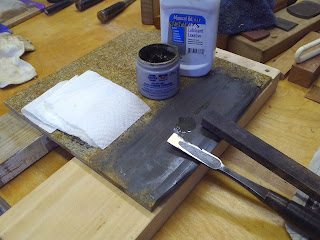I have used valve grinding compound (silicon carbide in a grease carrier). It's cheap, available at any auto parts store, and it works tolerably well.
You need to find a good substrate, though. This pink granite tile shows significant wear after lapping the backs of 4-5 chisels and a couple of really hard kanna blades.
Don't do this with your nice granite surface plate, OK?
The two Eze-lap stones that I have are not flat, but aside from that, still work well after years of use. All diamond stones lose some aggressiveness/harshness as they get broken in, but at least the ezelaps feel like they are still working.
The cheap Chinese stones that I have wear similar to the ezelaps and are sooooo inexpensive, they would be perfect, if only they were flat.
I want a diamond stone that has that firm "bite" of a good, coarse sandpaper, and if it could be recharged as it's performance began to fall, more the better. To that end, I have been experimenting with the use of loose diamond grit. The question is what type of substrate will work best. One other wrinkle..... I want to be able to use this for sharpening the bevel side. Others have said that loose diamond works poorly for doing bevels. Why?
I have some thick pieces of acrylic, the remnants of a bunch of old boat hatches that I didn't have time to use. You want to use a substrate that will allow the diamond grit to sink into, to grab onto, rather than just rolling around on the surface, and acrylic seems like it would work well.
I am using a 125-106 micron size, pretty coarse, about a #125 grit.
I put a small pinch into a syringe with a bit of glycerine as a carrier.
I sanded the acrylic to give it a bit of "tooth", then applied a little of the diamond compound. This is just the smallest fraction of what's in the syringe.
I used a piece of hard D2 steel to rub the stuff around, trying to distribute the diamond grit somewhat evenly. The black stick is a piece of oak that helps me bear down on the steel, really grinding the diamond into the substrate.
It works!
It feels funny, though, like the diamonds are mostly rolling around on the surface, instead of bedding in properly.
As the glycerine dries out, it needs to be scraped off of the blade. It is black from all of the iron and steel swarf, and I can't help but wonder how much of this is diamond that didn't embed. Rather than discard this stuff, I wet it slightly, then spread it around as though it was a typical waterstone slurry. You can feel the abrasive diamond rolling around still, and the feedback is pretty poor.
You can see the sparkles of diamond that DID get embedded into the substrate.
The glycerine rehydrates using just a spritz of water. Can't decide whether it is working better wet or dry.
The swarf and grunge rinses off very easily, using just a spray bottle. When I wipe off the nastiness, you can see that the diamond has been well distributed, but the concentration is thin.
I add more diamond compound to the plate, but it feels like it has reached a short of maximum capacity. This might be a misperception, but secondary (and third) applications don't dramatically improve the "feel" of the lapping plate.
The feel is hard to describe. There is a very distinct "grab" as though some of the diamonds are much larger than the others and cut deep grooves in the metal. The combination of coarse grit and deep grooves makes the plane iron steer funny. The blade gets pulled around rather than floating, and you get the sense that moving the iron back and forth is just riding in the same grooves rather than removing new metal.
It would be nice to get this figured out, as I have more window sills to plane. The Port Orford Cedar requires a very sharp edge for a nice finish.












Jason, You sure do have more patience and a more adventurous spirit than me. I just stick with the same old super-coarse water stone and Atoma diamond plate. I do like the looks of that window sill though and you have got me thinking...
ReplyDeleteHi Dave!
ReplyDeleteI don't know about the whole patience thing...... My problem seems to be more of a "Want it now!" issue. Like, "I want this bevel set NOW", and the diamond sharpening stones are sooooo nice, especially the Atoma's (Not that I actually HAVE one, but I've heard good things). Loose diamond grit is cheap now, if only I can figure out a way to use it effectively...... If nothing else, others can learn from my mistakes and hopefully save a few $$'s, haha!
If I could stop myself from buying these old fixer tools, I wouldn't need to mess around with the coarse grit stones so much. What type of super-coarse stone do you use, and do you like it? I've heard good things about the Sigma Power #120.....